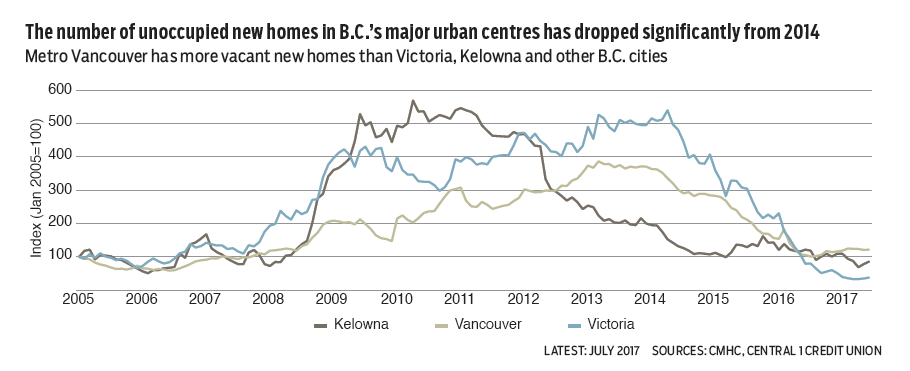Builders showed no sign of slowing construction in July as B.C. housing starts rebounded to a historically strong pace following a brief June pullback.
Provincial housing starts in urban areas rose to a seasonally adjusted annualized rate (SAAR) of 45,600 units, up 20% from June’s pace of 38,100 units.
Starts have averaged a pace of more than 42,000 (SAAR) since March after a weak start to the year.
High housing demand, low resale and new-home inventory, rising prices, and strong pre-sale conditions have underpinned construction activity.
Policy measures to cool the market, including tighter mortgage insurance qualification criteria and the foreign-buyer tax, have had few ill effects on new-home activity.
July’s rebound was owed to a 17% increase in the Vancouver census metropolitan area (CMA), reversing a prior month drop-off and a more than doubling of starts in Victoria.
July’s uplift narrowed the year-to-date decline from 2016’s near-record highs in urban starts to 4.4% from 9% at mid-year.
Vancouver CMA starts were still 13% lower than a year ago, but were partly offset by strong gains in Abbotsford-Mission (46%), Kelowna (67%) and Nanaimo (27%).

Expect high levels of new home construction to persist. June residential permits rose 6% from May and have climbed four consecutive months.
Meanwhile, the Metro Vancouver housing market has recovered in 2017 following a slowdown during the second half of 2016.
While the effect of the foreign-buyer tax still lingers, the strong economy and the contribution of the provincial down payment purchase program have provided a lift.
Market dynamics have changed over the past year as is evident when looking at sales by price range.
Essentially, sales of luxury homes (those costing $2 million or more) and higher-priced homes ($1.5 million to $2 million), equating to about 15% of the total market, have dropped sharply, by 35% to 40% from a year ago.
Demand has dropped due to the foreign-buyer tax, while quick gains from the sharp drop in the Canadian dollar have also dissipated with higher prices.
In contrast, sales have been relatively stronger in the $500,000 to $1 million range and $1 million to $1.5 million level, which are in reach for domestic professionals and move-up buyers, signalling strong demand from the local market. •
Bryan Yu is deputy chief economist at Central 1 Credit Union.




